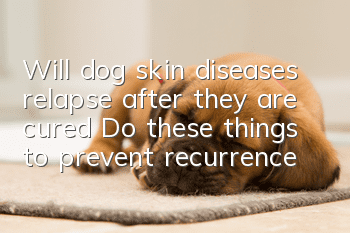Will dog skin diseases relapse after they are cured? Do these things to prevent recurrences

Causes of dog skin diseases
There are two main types of dog skin diseases, one is skin diseases caused by infection, Infectious skin diseases are mainly caused by mites, bacteria, fungi, fleas, ticks and other external parasites; there is also a skin disease caused by allergy, immune problems, etc., which Class called non-infectious skin diseases. In addition, there are other infectious factors.
Parasite-induced infection (infectious)
Mites are parasites with a particularly strong reproductive capacity and generally like to live in moist areas. The environment is one of the major causes of skin diseases in dogs. This parasite is usually hidden under the dog's skin, abdomen, inner thighs, around the lips, etc.
Bacterial infection Skin diseases are also very common. Bacteria are everywhere. Dogs’ daily outdoor activities, living environment, diet, etc. all contain bacteria. If you don’t pay attention to cleaning and disinfection, bacteria can easily spread. It invades the dog's body and causes skin diseases.
Fungi mostly parasitizes in the keratin tissue of dogs’ coat, epidermis, and toes. Fungal infection and skin diseases mostly occur in young dogs, old dogs, and those with weak constitutions and low body resistance. dog. Antifungal drugs such as terbinafine are used to treat fungal skin diseases.
Fleas are the most common parasitic insects on dogs. They are hidden on the surface of the dog's body, inside the thighs, armpits, under the neck, and deep in the fur. They can move and are visible to the naked eye. Fleas bite the blood and secrete toxins, causing severe itching and scratching in dogs.
Ticks are most active from June to November every year and grow in humid environments, such as grass and woods. Once a tick becomes parasitic on a dog, it will feed on the blood and secrete harmful substances. After being bitten by a tick, dogs will experience unbearable itching, anemia, weight loss, and stunted growth.
Caused by allergies and immune deficiencies (non-infectious)
Allergies are divided into food allergies and environmental allergies. Environmental allergies such as pollen and mosquitoes Irritation from bites, bath products, etc. can cause skin diseases; food allergies are more complicated and the allergen needs to be determined.
Immune deficiencies can also cause some skin diseases in dogs, such as discoid lupus erythematosus, pemphigus foliaceus, etc.
Caused by other factors
In addition, the lack of trace elements, vitamins, proteins, and minerals can also cause skin diseases in dogs. Such as copper deficiency, zinc deficiency, etc.
How to prevent the recurrence of skin diseases
Regular deworming
In fact, preventing dog skin diseases is more effective than Treatment moreimportant. To prevent skin diseases, the most important thing is to regularly treat dogs with internal and external insecticides to avoid diseases caused by parasitic infections in dogs.
Deworming is mainly divided into internal deworming and external deworming. Deworming is done every 1-3 months. For dogs who often go out, external deworming is done once a month. , internal deworming once every 3 months. It should be noted that anthelmintic drugs are toxic, so they must be fed as required. Generally, the dose of anthelmintic drugs that should be consumed is calculated based on body weight.
Maintain hygiene
The next thing to do is to keep the dog's living environment hygienic and healthy, and frequently disinfect kennels, food bowls and other dog supplies. A clean living environment can effectively prevent the growth of parasites and fungi in dogs. Therefore, it is particularly important to do a good job of disinfection to ensure that your home is clean.
In addition, you should also pay attention to keeping the dog's body surface healthy, bathing, trimming, and combing the hair regularly. Cleaning the dog's hair frequently, especially long-haired dogs, can better help the dog effectively remove dandruff and keep the dog's fur dry. Thus effectively preventing diseases.
Here it is emphasized that bathing frequently does not mean bathing frequently. Frequent bathing will damage the protective film on the dog's body surface. The best choice for bathing is dog body wash, not body wash. Second, after bathing, you must blow dry in time to keep your skin fresh and dry!
Enhance nutrition
When dogs’ bodies lack certain trace elements, their body resistance will decrease, causing a series of problems, so we usually Ensure your dog’s diet is nutritionally balanced to ensure their physical health and healthy skin.
Enhancing the dog’s comprehensive nutrition can improve the dog’s body resistance! In addition to dog food, owners should also mix it with fruits and vegetables. It should be noted that too much salt and oil in food eaten by humans can also cause itchy skin, so do not give it to dogs.
If your dog’s skin is more sensitive, you can also add some additional lecithin, nutritional cream, etc. to enhance your dog’s skin resistance. In addition, taking your dog to bask in the sun regularly can also prevent skin diseases!
Note: Do not let dogs use our human body wash. Because dog skin is weakly alkaline, while human skin is weakly acidic. Bath liquids for human use are generally alkaline and can neutralize with human skin. When the dog's weakly alkaline skin encounters the same alkaline shower gel, it cannot neutralize it. Instead, it washes away the oil that protects the skin surface, causing dryness, causing skin itching, allergies, dandruff and a series of other problems, reducing the skin's health. Immunity, causing skin diseases.
- Three common skin diseases in dogs: Keep dogs away from skin diseases
- Is Noble dog food good? Is Noble dog food imported?
- Completely correct your dog’s picky eating. This is how to cure your dog’s picky eating.
- What kind of dogs eat a lot? Do you know which dogs eat a lot?
- What behaviors should be prohibited for dogs? These prohibited trainings are related to the safety of dogs
- What kind of dog food is good for Pug? Teach you how to choose healthy and good dog food for Pug
- Taboos about raising dogs. Which of these taboos have you stepped on?
- What should you pay attention to when raising large dogs? What should you pay attention to when raising large dog puppies?
- What are the common skin diseases in dogs? These three skin diseases should not be taken lightly.
- How to choose a Pomeranian? I’ve taught you all the tips for choosing a Pomeranian. Why don’t you take a look?



